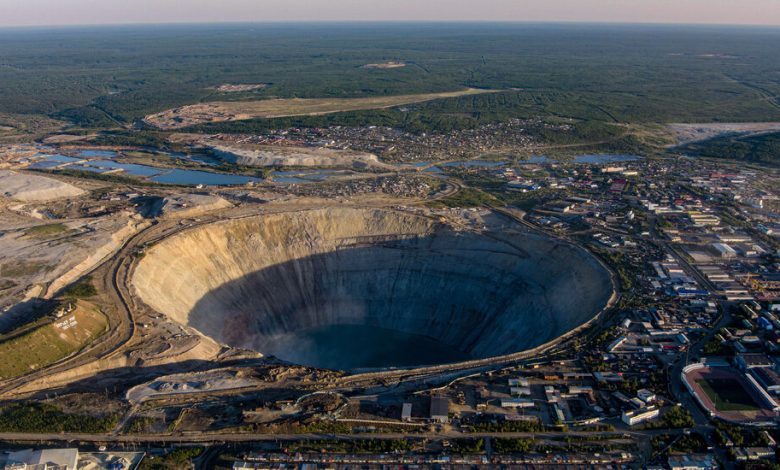When Ancient Eruptions Pumped Diamonds to Earth’s Surface

While diamonds might look pretty perched atop a ring, the rocks they hail from venture to Earth’s surface in a journey that’s anything but glamorous. Millions of years ago, some of our planet’s strangest and most violent volcanic outbursts dredged from deep underground most of the diamonds mined today in the form of blue-tinged rocks called kimberlites.
Unlike the volcanoes that more commonly pop up near the thinner edges of continents, the eruptions that produced most kimberlites came through the thick, stable continental cores known as cratons. Kimberlite eruptions start near the cratonic roots, at least 75 miles underground, and race upward at tens of feet per second — a fiery fury driven by an abundance of carbon dioxide and water.
“It’s like rocket fuel,” said Thomas Gernon, a geologist at the University of Southampton in England who has long studied kimberlites. The turbulent flow punches a carrot-shaped pipe through the ground, ripping out chunks of deep subsurface rock, including some that are studded with diamonds.
But existing research still has a giant diamond-shaped hole: Why do kimberlites form?
A new study led by Dr. Gernon and published Wednesday in the journal Nature points to the ancient roots of these eruptions. He and his colleagues report that the breakup of ancient supercontinents like Pangaea and Rodinia caused deep disruptions in the flow of the mantle beneath Earth’s crust, setting off the blasts.
Scientists have long known that formation of kimberlites (named for Kimberley, South Africa, where they were first found) coincide with the breakup of supercontinents. But that relationship is poorly understood. One idea posits that the deep plumes of rising, hot mantle that may drive continental breakup could also fuel kimberlite formation. But kimberlites “have no whiff of plume in their chemistry,” Dr. Gernon said.
To solve this mystery, Dr. Gernon and his team analyzed statistical correlations between continental breakups and kimberlite blasts during the last billion years. The results reveal that the two are strongly linked, but they discovered something unexpected: The eruptions were delayed, with most kimberlites having formed about 26 million years after supercontinents broke up.
That sent him and his colleagues down a series of diamond-studded rabbit holes to test the strength of the link and explain the delay.
The team’s computer modeling suggests that as continents pull apart, hot mantle wells up in a churning convection that heats and tugs on the root, or keel, of a continental core. The keel drips downward like wax, producing eddylike currents in the mantle.
As bits of the keel’s carbonate- and water-rich rocks mix into the churning mantle, they could melt just enough to form an effervescent magma similar to kimberlites that would hurtle to the surface. The churning mantle can cause ripples at the craton’s base, setting off eruptions over tens of millions of years, helping explain why many kimberlites seem to migrate toward continental interiors over such a long time.
“Their analysis presents a really compelling evidence base to support their model,” said Janine Kavanagh, a volcanologist at the University of Liverpool in England.
But the case is not yet closed. Philip Janney, a mantle geochemist at the University of Cape Town, praised the group’s statistical analysis but said that the study only showed the strong influence of supercontinent breakup on kimberlite eruptions — “not that it is the only important factor.”
Supercontinent breakups are periods marked by a tangled web of interconnected processes that sculpt the surface. And many older kimberlites also emerge around periods of subduction, or continental smash-ups, further muddying the picture, Dr. Janney said.
That makes it difficult to pin down kimberlite eruptions’ cause, especially because no one has witnessed one of the furious blasts. “We just have what’s preserved on the surface today,” said Ben Mather, a geophysicist at the University of Sydney.
Though challenging to study, kimberlites promise to yield a sparkling window into the geologic churn deep below the surface — and perhaps above, too, Dr. Gernon said. The loss of the thick keel from a continent’s craton could have caused the land to bob upward like a buoy, wreaking havoc at the surface in a cascade of impacts that the team is still studying.
“There’s still many mysteries about kimberlites that are yet to be revealed,” Dr. Mather said.




